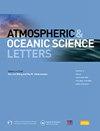全球变暖加剧了中国十年一遇的夏季极端降水
IF 3.2
4区 地球科学
Q3 METEOROLOGY & ATMOSPHERIC SCIENCES
引用次数: 0
摘要
全球变暖背景下极端降水的加剧给人类安全和社会进步带来了重大威胁。研究全球变暖对中国罕见EP事件的具体影响,不仅可以增强对这些变化的理解,而且可以为制定积极的策略来减轻相关损害铺平道路。大集合模拟结果表明,近几十年来,全球变暖导致中国西部和中部部分地区10年一遇的EP事件增加,其中南亚高压(SAH)的增强起主导作用。南亚高压的增强与对流层下层西太平洋副热带高压的增强和向西扩展相对应。这两个系统之间的区域向上运动增强,西南水汽输送增加,导致中国西部和中部气候降水增加,从而提高了十年一遇的EP事件的阈值。中文意思是:“我的意思是,我的意思是,我的意思是,我的意思是,我的意思是。”研究全球变暖对中国罕见极端降水事件的影响, 不仅能加深大家对这些变化的理解, 还为制定应对政策铺平了道路. 大样本模拟数据表明,在过去几十年中,全球变暖加剧了中国西部和中部部分地区十年一遇的极端降水事件,其中因全球变暖而增强的南亚高压(SAH)起到了主导作用。这句话的意思是:“我的意思是,我的意思是。”这两个系统间的区域经历了更强的上升运动和增强的西南水汽输送, 导致中国西部和中部的气候态降水增加, 从而提高了十年一遇极端降水事件的阈值.本文章由计算机程序翻译,如有差异,请以英文原文为准。
Global warming intensifies once-in-a-decade extreme precipitation in summer in China
The intensification of extreme precipitation (EP) under global warming presents a substantial risk to human safety and societal progress. Studying the specific impacts of global warming on rare EP events in China not only enhances the comprehension of these shifts, but also paves the way for the development of proactive strategies to alleviate associated damages. Results from large-ensemble simulation data demonstrate that global warming has led to an enhancement in once-in-a-decade EP events in parts of western and central China over the past few decades, with the strengthening of the South Asia high (SAH) caused by global warming playing a dominant role. The strengthening of the SAH corresponds to an intensification and westward extension of the western Pacific subtropical high in the lower troposphere. The region between these two systems experiences enhanced upward motion and increased southwesterly water vapor transport, leading to a rise in climatological precipitation in western and central China, thereby raising the threshold for once-in-a-decade EP events.
摘要
全球变暖下极端降水 (EP) 的加剧对人类安全和社会发展构成了重大威胁. 研究全球变暖对中国罕见极端降水事件的影响, 不仅能加深大家对这些变化的理解, 还为制定应对政策铺平了道路. 大样本模拟数据表明, 在过去几十年中, 全球变暖加剧了中国西部和中部部分地区十年一遇的极端降水事件, 其中因全球变暖而增强的南亚高压 (SAH) 起到了主导作用. SAH的增强与对流层低层西太副高的增强西伸密切相关. 这两个系统间的区域经历了更强的上升运动和增强的西南水汽输送, 导致中国西部和中部的气候态降水增加, 从而提高了十年一遇极端降水事件的阈值.
求助全文
通过发布文献求助,成功后即可免费获取论文全文。
去求助
来源期刊

Atmospheric and Oceanic Science Letters
METEOROLOGY & ATMOSPHERIC SCIENCES-
CiteScore
4.20
自引率
8.70%
发文量
925
审稿时长
12 weeks
 求助内容:
求助内容: 应助结果提醒方式:
应助结果提醒方式:


